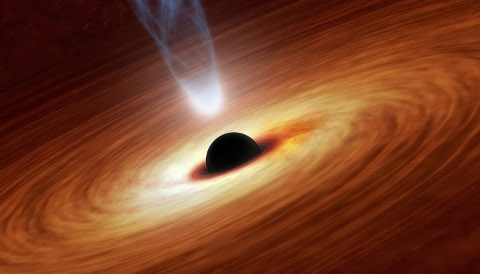
Does a Fifth Force Permeate the Universe?
A team of theoretical physicists thinks a fifth force could explain an anomaly spotted in a nuclear physics experiment. If true, it could have huge ramifications for particle physics and dark matter — but that’s a pretty big if.

LIGO Detects Second Black Hole Collision
The gravitational wave observatory has detected a second event, heralding a new era in astrophysics. The day after Christmas last year, the cosmos quietly gifted scientists with gravitational waves — ripples in the fabric of spacetime – produced in a collision between two stellar-mass black holes. It’s the second event…

Long-Ago Supernovae Littered Earth
Roughly 2 million years ago, as the human ancestor homo erectus was descending from the trees, two supernovae exploded nearby and showered Earth with debris.

Mysterious Radio Burst Repeats Itself
A brief burst of radio waves has been observed repeating, enabling astronomers to settle its exotic origin.

Astronomers Pinpoint Mysterious Radio Burst
A radio burst with the energy of a hundred million Suns has finally been placed on the cosmic map, enabling scientists to investigate the origin of these mysterious bursts.

Stars Form in Turbulent Times
New images of four circumstellar disks suggest that the star formation process is much more violent than previously thought.

A Galaxy Hit-and-Run
Ripples found in the Milky Way’s disk reveal our galaxy survived an ancient hit-and-run. Now, astronomers might have caught the culprit.

Seeing Shadows of Ancient Galaxies
A new technique lets astronomers measure nearly invisible clouds of hydrogen gas from across the universe.

About The LIGO Gravitational-Wave Rumor. . .
Gossip is racing around the physics and astronomy community: has LIGO finally heard its first black-hole merger? Here’s the reality.

New Clues in Cooking up Planets and Stars
An early peak at a forming star system reveals tantalizing clues about its origin.

Telltale Shock Waves from Runaway Stars
Astronomers are now finding dozens of fast-moving runaway stars by searching for the bow shocks they create in interstellar gas and dust.

A Dusty Mystery Around AU Microscopii
Unexplained ripples have been found racing through a dusty disk.

Twin Stars Simplify Distance Measurements
A new technique that relies on identifying stellar twins yields a novel way to measure the distances to stars.

Black Hole Too Big for its Breeches
A supermassive black hole in the early universe is at least 10 times too heavy for its host galaxy, raising questions about galaxy and black hole coevolution.

Microwave Ovens Spark Radio Signals
After 17 years, researchers using the Parkes radio telescope in Australia have identified the culprit behind a mysterious type of radio signal: two on-site microwave ovens.

Best Evidence Yet That Black Holes Exist
A team of astronomers has found indirect evidence of a supermassive black hole’s event horizon, providing further proof that these wacky objects actually exist in nature.

A Star’s Closest Flyby to the Sun
A red dwarf and its brown dwarf companion buzzed through the outer Oort Cloud some 70,000 years ago, around the time when modern humans began migrating from Africa into Eurasia.

Do Atmospheres Spin Worlds to Habitability?
The best place to look for nearby Earth-size planets are around the smallest, coolest stars. New research shows that any exoplanets tightly circling their stars might have a better chance of being habitable than previously thought.

Watching a Quasar Shut Down
Over the course of ten years, a once-brilliant quasar seems to have stopped gobbling down nearby gas.

Breathtaking View of Icy Moon Europa
A newly processed image from NASA’s Galileo spacecraft shows Europa’s breathtaking beauty and tortured surface in greater detail than ever before.
